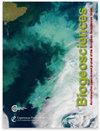Nodosariida(有孔虫)中元素/钙比值及其在古环境重建中的潜在应用
IF 3.9
2区 地球科学
Q1 ECOLOGY
引用次数: 0
摘要
摘要有孔虫壳的化学成分是古海洋学中重建过去环境和气候的一个众所周知的工具。它们的应用是基于环境变量与钙化过程中元素掺入浓度或稳定同位素分馏之间的关系。这些所谓的代理关系绝大多数都是基于轮状虫的有孔虫目,例如,它包括了所有现存的浮游生物物种。然而,有孔虫目中有钙化成员的目更多,其中一些具有根本不同的生物矿化途径,如Nodosariida、Polymorphinida和Vaginulinida。它们都属于Nodosariata类,产生方解石壳,可能是古环境和气候信号的载体。这些壳的微观结构和有孔虫的整体形态与轮状虫有很大的差异,表明它们的元素和稳定同位素组成不一定对环境参数有相似的反应。Nodosariata的一个潜在优势是它们在化石记录(石炭纪)中出现的时间比Rotaliida(侏罗纪)要早得多,从而可能大大扩展了以有孔虫为基础的古海洋学重建的范围。为了验证Nodosariata有孔虫作为古代用物的潜在应用价值,我们从墨西哥湾样带取样,研究了11种物种中5种元素与环境参数的关系。它们的元素组成(B / Ca、Na / Ca、Mg / Ca、Sr / Ca和Ba / Ca)与其他有孔虫目不同,具有明显的地球化学特征。结果还显示,随着温度的升高,Mg / Ca值也增加,这与已知的Rotaliida相似,这表明Nodosariata壳可能对古温度重建有用。Nodosariata与Rotaliida在形态、壳微观结构和整体地球化学组成上存在较大差异,二者的Mg / Ca-temperature calibration差异表明,Mg / Ca-to-temperature的关系部分独立于确切的钙化机制。我们比较了有孔虫目中Mg / Ca温度灵敏度,并描述了平均Mg / Ca与Mg / Ca温度校准灵敏度之间的关系。对于其他元素,与Mg / Ca相比,跨数量级的变异性较小,这导致更相似的El / Ca环境校准。本文章由计算机程序翻译,如有差异,请以英文原文为准。
Element ∕ Ca ratios in Nodosariida (Foraminifera) and their potential application for paleoenvironmental reconstructions
Abstract. The chemical composition of foraminiferal shells is a well-known tool in paleoceanography to reconstruct past environments and climate. Their application is based on the relation between environmental variables and the concentration of elements incorporated or stable isotope fractionation during calcification. The vast majority of these so-called proxy relationships are based on the foraminiferal order of the Rotaliida, which, for example, encompasses all living planktonic species. However, there are more orders of foraminifera with calcifying members, some of which have fundamentally different biomineralization pathways, such as the Nodosariida, the Polymorphinida and the Vaginulinida. All these belong to the class of the Nodosariata and produce calcite shells, which may serve as carriers of paleoenvironmental and climate signals. The microstructures of these shells and overall morphology of these foraminifera strongly deviate from the Rotaliida, suggesting that their elemental and stable isotopic composition do not necessarily respond similarly to environmental parameters. A potential advantage of the Nodosariata is that they appear considerably earlier in the fossil record (Carboniferous) than the Rotaliida (Jurassic), thereby possibly extending the range of foraminifer-based paleoceanographic reconstructions considerably. To test the potential application of Nodosariata foraminifera as paleoproxies, we investigated incorporation of 5 elements in 11 species as a function of environmental parameters from a transect sampled in the Gulf of Mexico. Their element composition (B / Ca, Na / Ca, Mg / Ca, Sr / Ca and Ba / Ca) shows a distinct geochemical signature for these foraminifera, different to that of members of other foraminiferal orders. Results also show an increase in Mg / Ca values with increasing temperature, similar to that known for the Rotaliida, which suggest that Nodosariata shells might be useful for paleotemperature reconstructions. The difference in Mg / Ca–temperature calibration in Nodosariata compared to Rotaliida, with the large differences in their morphology, shell microstructures and overall geochemical composition, suggests that the Mg / Ca-to-temperature relationship is partly independent of the exact calcification mechanism. We compare Mg / Ca–temperature sensitivities across foraminiferal orders and describe a relationship between the average Mg / Ca and the sensitivity of the Mg / Ca–temperature calibration. For other elements, the variability across orders is smaller compared to that in Mg / Ca, which results in more similar El / Ca–environmental calibrations.
求助全文
通过发布文献求助,成功后即可免费获取论文全文。
去求助
来源期刊

Biogeosciences
环境科学-地球科学综合
CiteScore
8.60
自引率
8.20%
发文量
258
审稿时长
4.2 months
期刊介绍:
Biogeosciences (BG) is an international scientific journal dedicated to the publication and discussion of research articles, short communications and review papers on all aspects of the interactions between the biological, chemical and physical processes in terrestrial or extraterrestrial life with the geosphere, hydrosphere and atmosphere. The objective of the journal is to cut across the boundaries of established sciences and achieve an interdisciplinary view of these interactions. Experimental, conceptual and modelling approaches are welcome.
 求助内容:
求助内容: 应助结果提醒方式:
应助结果提醒方式:


